Physical Address
304 North Cardinal St.
Dorchester Center, MA 02124
In this chapter, we examine the lymphatic system ( Fig. 168.1 ) and its malfunction with a focus on current nonoperative treatments. The diagnosis and surgical treatment of lymphedema are discussed in other chapters. It is important to know that pathology of the lymphatic system is linked mainly to lipid and protein malabsorption, accumulation of protein-rich interstitial fluid, and the inability to return lymph to the systemic circulation leading to the development of lymphedema. Since there is no cure for lymphedema, treatment strategies focus on methods to reduce limb swelling and prevent secondary infections. A variety of mechanical therapies that share the common goals of reducing limb volume and preventing recurrence serve as the cornerstones of current contemporary management. Other components of nonoperative management include skin hygiene, appropriate clothing, avoidance of trauma, and compression techniques and physiotherapy. Other treatment modalities are discussed briefly, including, pharmacotherapy, laser therapy, and gene therapy. Failure to manage chronic lymphedema may result in devastating limb swelling with increased morbidity, decreased quality of life and productivity, increased risk of infection, and even rarely late-onset malignancy. Lastly, we briefly discuss the psychological status of the patients, insurance concerns, and what would be considered the ideal lymphedema clinic.
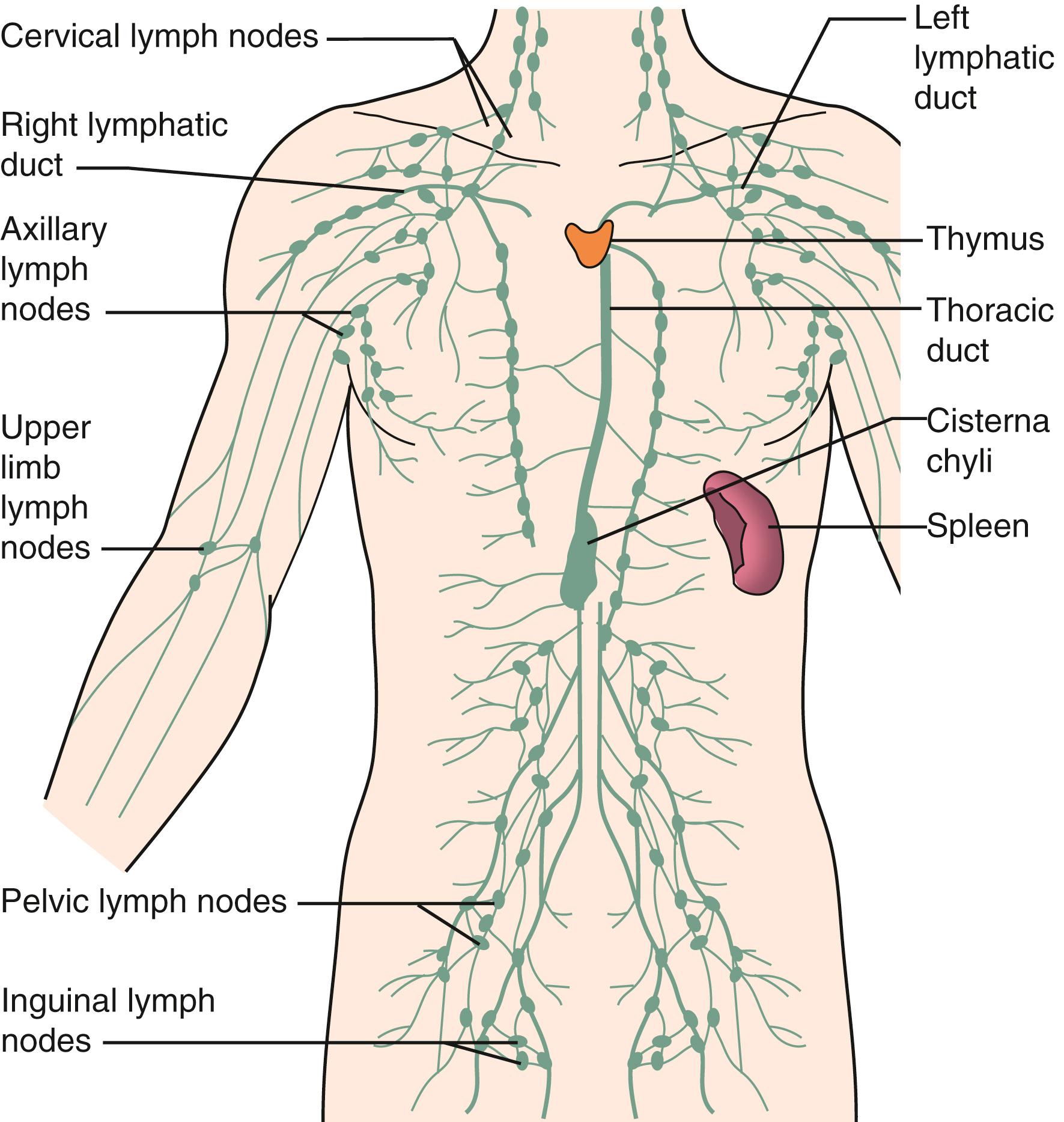
In general terms, lymphedema is the result of an imbalance between the production and transport of lymph, which leads to an accumulation of protein-rich fluid in the interstitial spaces. This imbalance may be the result of increased production of lymph which exceeds the maximal transport capacity of normal lymphatic conduits (so-called “high-input failure”) such as occurs in the setting of venous hypertension. Alternatively, congenital absence or deficiency of normal lymphatic channels or damage to lymph vessels by infection, surgery or radiation, may reduce the capacity of the lymphatic system to handle even a normal volume of lymph production (“low output failure”). In either case, the net effect is an accumulation of extracellular, protein-rich interstitial fluid that may lead to a cascade of inflammatory changes culminating in progressive, irreversible subcutaneous fibrosis. Given the central role of the lymphatic system in potent immune responses, lymphedema results in increased risk for infection and rarely, late-onset malignancy.
Lymphedema is classified as primary or secondary. Primary lymphedema is typically related to developmental aplasia, hypoplasia, agenesis, or fibrosis of the lymphatic system. Congenital primary lymphedema is usually recognized in the first year of life and is more common in boys than girls. When primary lymphedema appears before the age of 35, it is called “lymphedema praecox.” If it appears after the age of 35, then it is referred to as “lymphedema tarda.” Both lymphedema praecox and tarda are 2 to 10 times more common in females than males.
Secondary lymphedema is much more common than primary lymphedema and is most frequently related to lymph node dissection, radiation, traumatic injury or malignancy ( Fig. 168.2 ). Of note, chronic venous disease (CVD) is a common cause of secondary lymphedema and it called venous lymphedema ; it is sometimes misdiagnosed as primary lymphedema leading to suboptimal treatment.
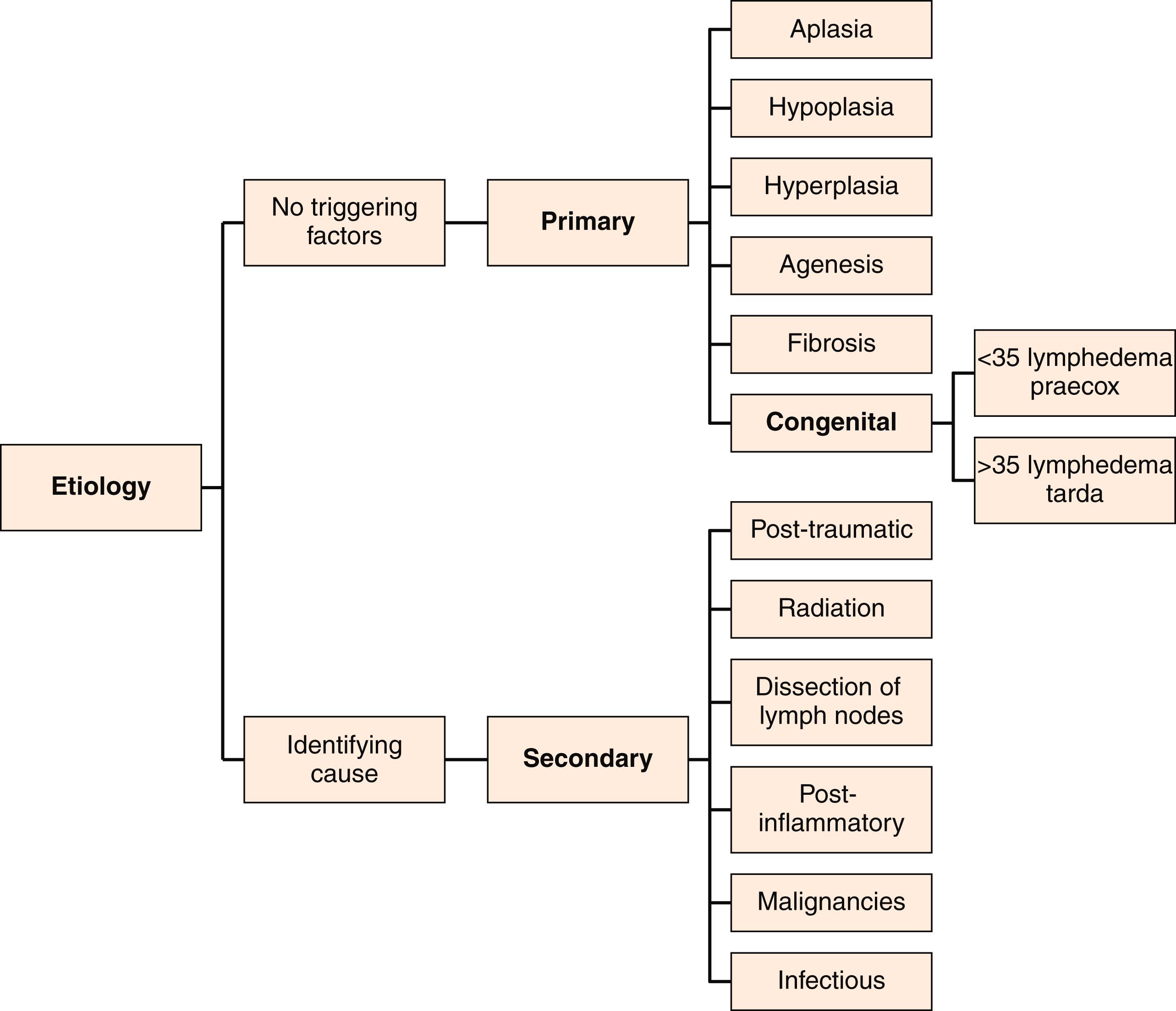
The diagnosis of lymphedema can usually be based on history and physical examination. The clinical history should include age of onset, areas of involvement, the progression of symptoms, family history, past medical history including any related surgery, travel, trauma, and radiation. The physical exam should focus on the distribution, severity, and character of edema. The International Society of Lymphology describes, Stage I lymphedema as characterized by soft pitting edema that is largely reversible with elevation. Stage II is irreversible, characterized by fibrosclerotic changes, inflammation, hardening, or thickening, along with non-pitting edema. Stage III or lymphostatic elephantiasis is characterized by an extreme increase in the size and texture of the skin often with typical papillomas and/or deep skin folds. Stemmer’s sign describes the inability to pick up a fold of skin at the base of the second toe due to the loss of skin elasticity. A prominent transverse crease across the front of the ankle is common. Peau d’orange (literally “skin of the orange”) describes the cutaneous edema typical of lymphatic obstruction. Duplex ultrasound of the venous system is appropriate to rule out the presence of venous pathology. Chronic venous hypertension may lead to the accumulation of interstitial fluids that increase the workload on the lymphatic system to adequately drain the interstitial fluid resulting in a mixed disease called venous lymphedema. Lymphoscintigraphy is both sensitive and specific for lymphedema. Conservative treatment with repeat lymphoscintigraphy is recommended for a patient with an initial negative study and high clinical suspicion of lymphedema ( Fig. 168.3 ). Another classification method considers the malignant versus benign features of the lymphedema ( Fig. 168.4 ).
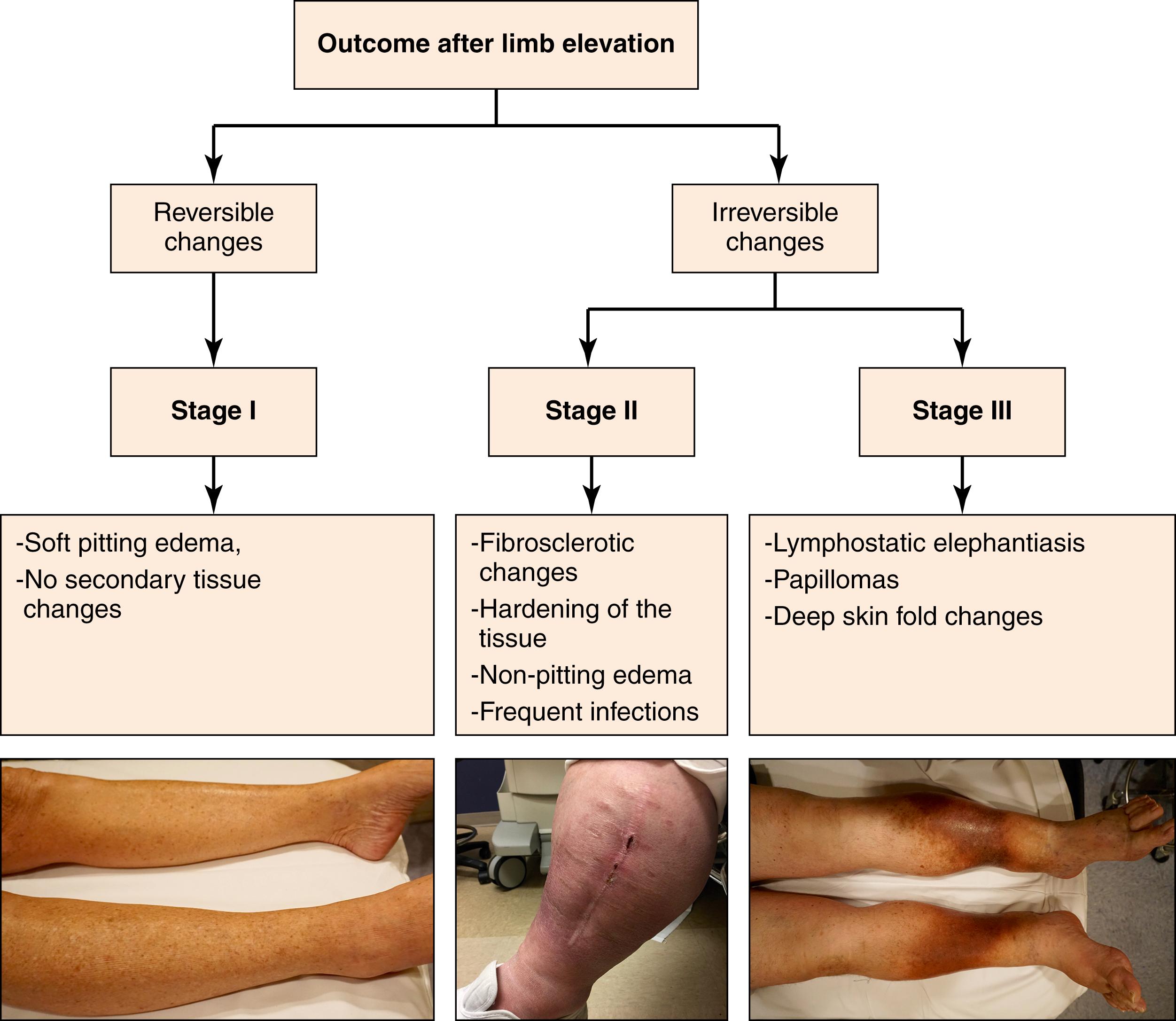
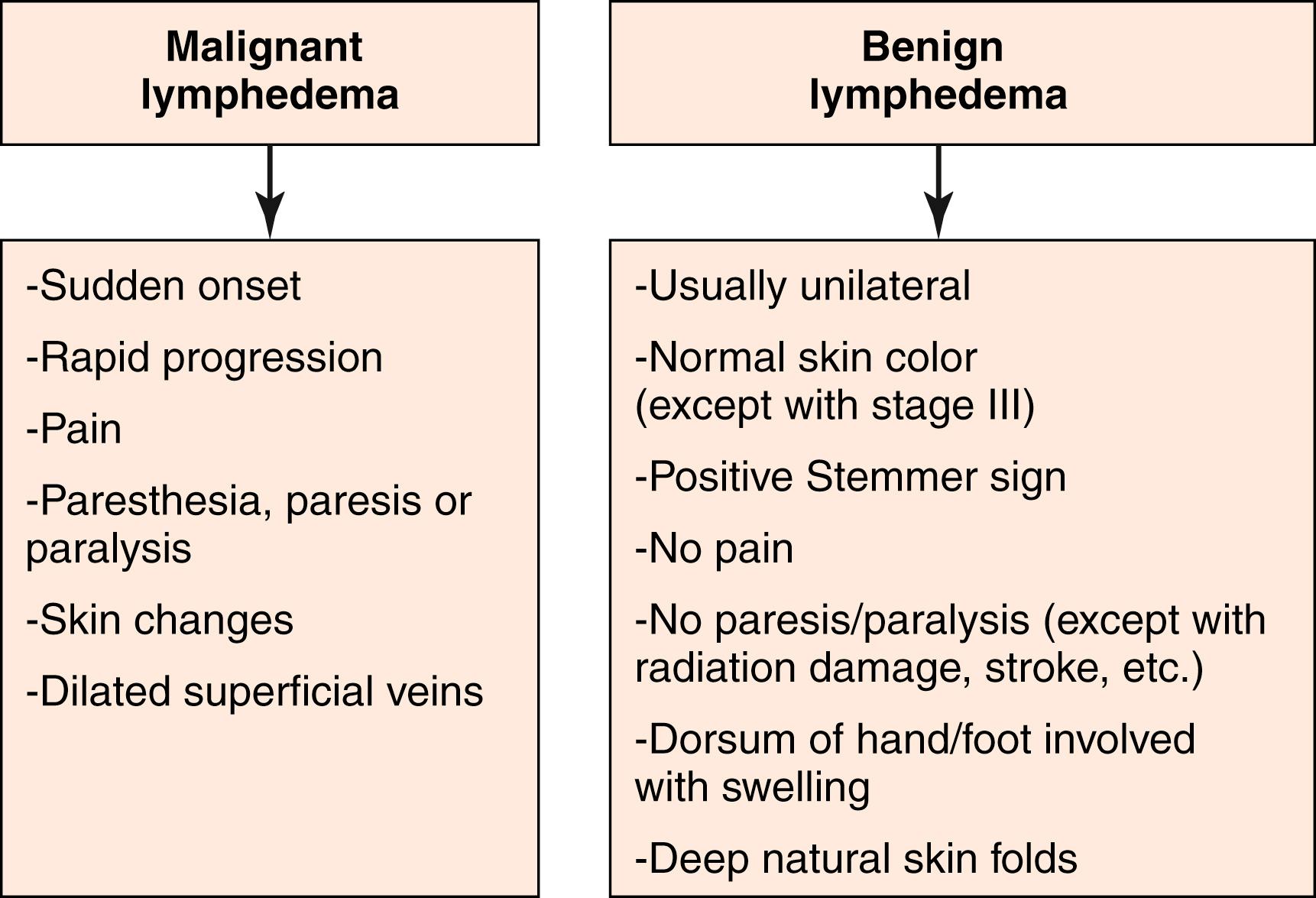
The approach most often used to classify lymphedema is the Common Terminology Criteria for Adverse Events v3.0, which was developed for grading adverse events in the context of clinical trials. This grading system provides not only objective measures (inter-limb discrepancy in volume or circumference), but also subjective and clinical assessments for lymphedema diagnosis ( Table 168.1 ).
| Grade | Inter-Limb Discrepancy | Visible Difference |
|---|---|---|
| I | 5%–10% | Swelling or obscuration of anatomic architecture on close inspection; pitting edema |
| II | 10%–30% | Readily apparent obscuration of anatomic architecture; obliteration of skin folds; readily apparent deviation from normal anatomic contour |
| III | More than 30% | Gross deviation from normal anatomic contour; interfering with activities of daily living |
| IV | Progression to malignancy (e.g., lymphangiosarcoma); amputation indicated; disabling lymphedema | |
There are other rare forms of lymphedema such as Meige disease (which has autosomal dominant inheritance, a familial type of lymphedema praecox associated with distichiasis), , , , Milroy disease (which has autosomal dominant with incomplete penetrance), and yellow nail syndrome (which is a rare disorder that occurs after the age of 50 but the juvenile form has been reported. Although the etiology remains unclear, there is a role of the lymphatic impairment. The syndrome is diagnosed when the triad of yellow nail discoloration, lower limb lymphedema, and pulmonary manifestations (a chronic cough, bronchiectasis, pleural effusion) coexist. Usual treatment is oral vitamin E, antifungal, surgical removal of the pleural effusion, along with lymphedema treatment.
Identifying patients who are at risk is the essential step for preventive medicine. In undeveloped countries, Wuchereria bancrofti is the most common cause of lymphedema and filariasis. The effort to decrease the transmission in endemic areas may decrease the incidence of lymphedema; the mass administration of diethylcarbamazine plus ivermectin significantly decreased lymphatic filariasis. , It was reported that higher doses of albendazole did not improve the result, but on the other hand, was associated with more severe side effects. It was suggested that alternative regimens could be useful in the later stages of existing programs or to achieve elimination more rapidly in areas where programs have yet to start.
In developed countries, there are two groups of patients who are at high risk of developing lymphedema. The first group contains patients who undergo radiation of a lymph node group and/or surgical lymphadenectomy as part of cancer treatment. Efforts to spare lymph nodes during cancer treatment have proven to be effective in reducing the incidence of lymphedema. For instance, for patients with breast cancer, the standard of care in staging has evolved from dissection of 2nd ± 3rd level axillary lymph nodes to performing sentinel lymph node biopsy, followed by complete dissection only if nodal metastases are detected; this approach has reduced the incidence of lymphedema by approximately 80%. Similarly, the use of sentinel lymph node biopsy to identify lymph nodes involved by metastatic melanoma has significantly reduced the need for extensive inguinal and pelvic lymphadenectomy and has also reduced potential lower extremity lymphedema. Interestingly, it also has been reported that being obese or overweight may place women at risk for developing lymphedema following breast cancer treatment, and is considered a major risk factor for lymphedema. , It is also worth noting that BMI over 50, 9 the extent of local surgery, local radiation, delayed wound healing, and tumor-related lymphatic obstruction are also risk factors that exacerbate the risk of lymphedema development in patients being treated for breast cancer.
The second high-risk group is patients with recurrent cellulitis; a damaged lymphatic system that undermines the system’s functional capacity and eventually causes lymphedema. Recurrent cellulitis may cause permanent irreversible lymphatic compromise. Other forms of chronic infection can cause sufficient inflammation to damage the lymphatics. However, because lymphedema is the strongest risk factor for cellulitis, , at times it is difficult to distinguish between cellulitis as the initial presentation of previously subclinical lymphedema or independently caused lymphedema. The low-grade chronic inflammation produced by rosacea could be caused by the lymphedema of facial structures, particularly the eyelids. The goal of starting prophylactic antibiotics for this group is necessary to prevent recurrent infection. The aim of current therapy should be directed at resolving acute infections and the prevention of recurrent episodes of cellulitis ( Fig. 168.5 ).
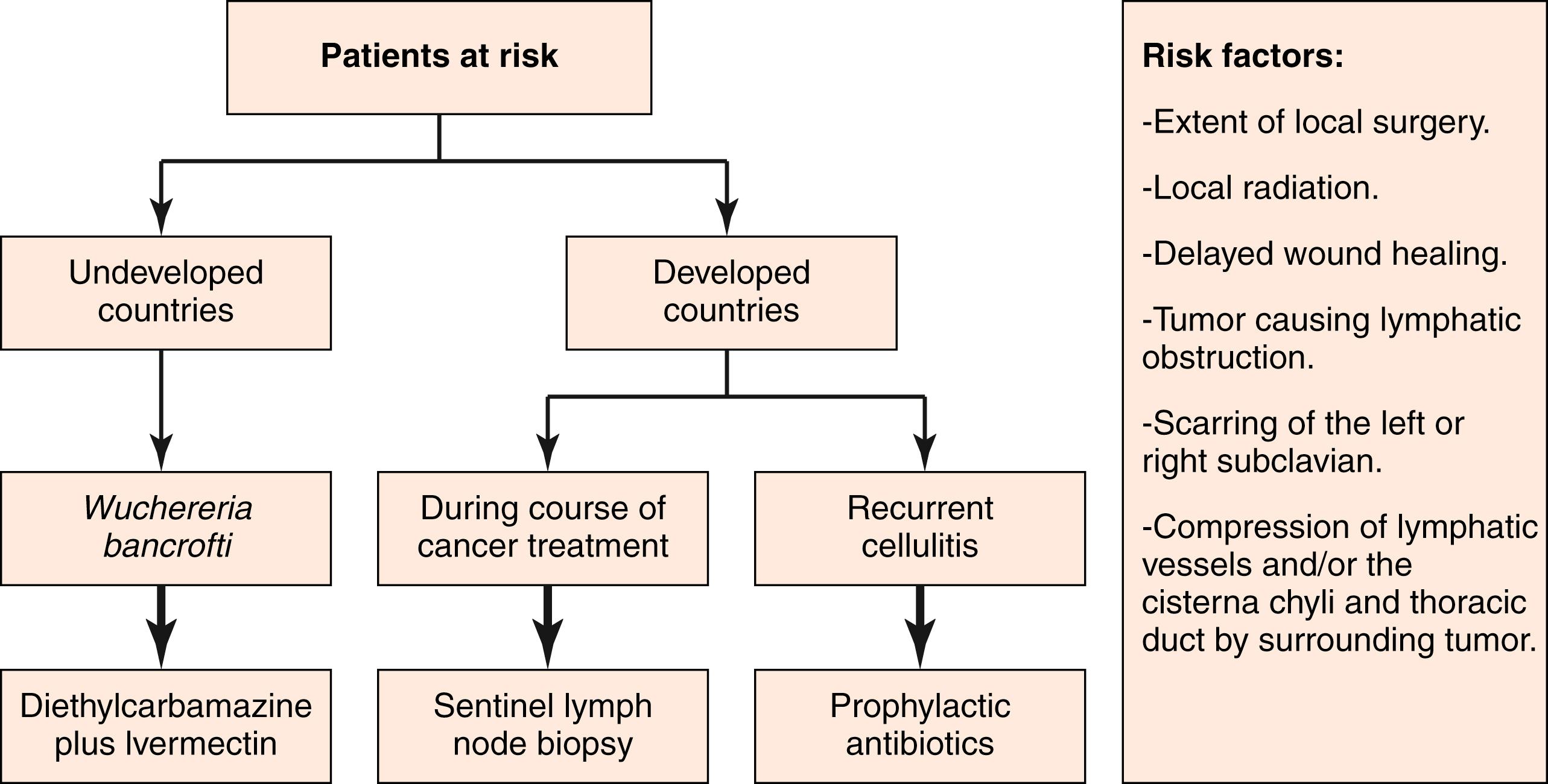
Patients with a history of fungal infection, including candidiasis and tinea, should use topical antifungal medications. Routine use of topical clotrimazole cream (1%) or miconazole nitrate lotion or cream (2%) is sufficient for most patients. Oral fluconazole or itraconazole may be needed for recalcitrant or extensive infection. No studies have definitively addressed the efficacy of these treatments in terms of documenting a decreased incidence of lymphedema in those patients.
It has been reported that lifestyle modifications, such as changes in diet and increased exercise, have helped to decrease the progression of lymphedema. , In terms of preventive care, several self-care measures can be practiced to decrease lymphedema, including maintaining daily skin hygiene (e.g., the limbs should be washed regularly with soap and water) and it is important to avoid trauma; either of these can be the nidus of infections.
Other lifestyle or daily habits include elevating the affected limb, modifying dietary intake to include less salt and more protein, wearing properly fitted compression stockings, and walking and performing aerobic exercises to promote lymphatic flow. It is important to monitor and measure limb volume as an objective parameter during the follow-up with patients with lymphedema.
Exercise helps to decrease lymphedema swelling; during the contraction phase of the muscle, the lymph gets pushed to an alternative lymph node through the lymph vessels. , Historically, patients at risk for developing lymphedema have been advised against “overusing” their at-risk body parts for fear of triggering lymphedema. This recommendation is based on anecdotal associations of the initial onset of lymphedema with episodes of vigorous exercise or sustained, repetitive use of the at-risk extremity. Recommendations against exercise have recently been tempered and re-phrased, based on the results of several randomized controlled trials. , These trials revealed that a gentle, incremental program of full-body resistive training, started at a low level and increased gradually, did not increase the incidence of lymphedema among at-risk breast cancer survivors, and might have been protective. Similar trials have yet to shed light on the risk–benefit profile of exercise in lower extremity lymphedema. An international study LIMPRINT (Lymphoedema IMpact and PRevalence-INTernational) sought to evaluate the size and impact of lymphedema and chronic edema in different countries and health services across the world. That study highlighted that prevalence of chronic edema varied according to the facility type, ranging from 5.0% to 66.1%.
Exercise routines should include combinations of lymphedema remedial exercises (e.g., active, repetitive, non-resistive motion of the involved body part) along with three main types of exercise (i.e., aerobic, strength, and flexibility). Other possible types of exercise could be considered but have not been adequately studied in people with lymphedema (e.g., Pilates, yoga, Tai Chi, Qigong, aquatic exercise, trampoline rebounding, breathing exercises, and relaxation). Finally, patients should avoid exposure to extreme heat or cold, at least to the extent that tissue injury may occur, such as a burn or frostbite ( Fig. 168.6 ).
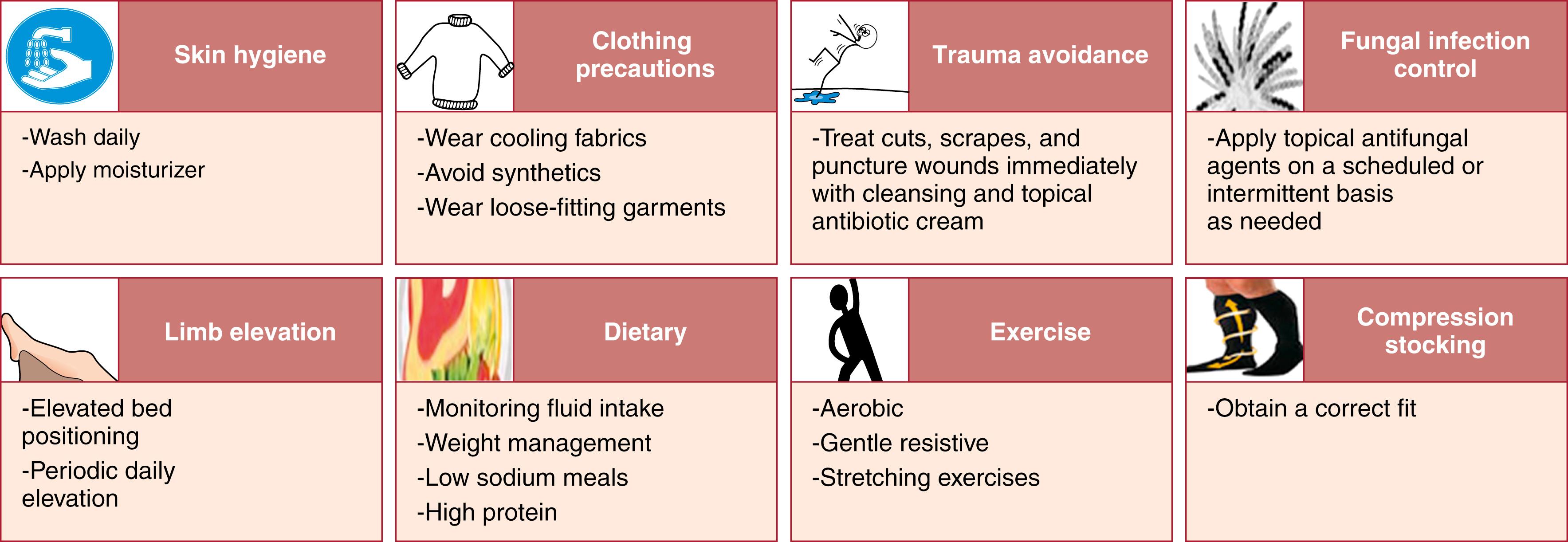
Currently, there is no cure for lymphedema, and management is based on a series of lifelong physical therapies. Practitioners at lymphedema centers or clinics should set specific goals tailored to each patient, while at the same time base treatment on the stage and grade of the lymphedema. The aim of the treatment and goals should be to minimize limb diameter, decrease edema, maintain skin integrity, prevent infection, and encourage patients to use self-care to monitor their skincare and weight reduction.
The standard of care for lymphedema is commonly referred to as complex decongestive therapy (CDT). CDT was popularized in Europe by Földi et al., Kasseroller, and Leduc et al., as well as Casley-Smith in Australia, and was later introduced to the United States in the early 1990s; CDT continues to be first-line therapy for stage II and III lymphedema. CDT’s success has been documented worldwide. It is the combination of four components and two phases. The components are: (1) manual lymphatic drainage; (2) compression bandaging; (3) compression garments; and (4) compression devices. Volume reductions were reported after the use of compression garments, pumps, and manual lymphatic drainage. However, the greatest improvements were reported when these treatments were combined in a treatment program.
The two phases are:
Initial or reductive phase (phase I); the aim to reduce the size of the affected area and to emphasize proper skincare.
Maintenance phase (phase II), which begins immediately after phase I; the main aim is to maintain the gains made during phase I, and requires life-long self-maintenance.
Although very successful, CDT requires a large investment of time from the therapist and patient. Therapists must be specially trained to perform standardized techniques of manual lymph drainage (MLD) and complex multilayered wrapping. Currently, the treatment is offered in specialized practices, but other programs are becoming more widely available. In the United States, there is a voluntary certification process that involves documentation of training, logging treatment hours, and a certification examination to ensure competence. This effort was initiated and coordinated by the Lymphology Association of North America (LANA). Certified therapists are listed on LANA’s website, which can be searched by name, state, or zip code. Although phase I CDT can achieve abrupt and dramatic reductions in limb volume, long-term success requires ongoing phase II home-based program maintenance. Without consistent adherence to the program, a patient’s lymphedema volume will re-accumulate. The multi-week intensive treatment program also may be limited by insurance coverage in the United States; modified programs, often with inferior outcomes, maybe a patient’s only option. An alternative program that utilizes home compression bandaging and exercise may achieve comparable results to conventional CDT in some patients with milder (e.g., stage II) lymphedema. Patient compliance and adherence to the therapy is normally 60% to 70%, which in turn, requires trained therapists to have an average volume reduction of 50%. , It is worth mentioning a recent pilot study to compare the short-term effects of hyperbaric oxygen therapy (HBO) and CDT in 10 patients with breast cancer-related lymphedema, who were divided into two groups and received 10 treatments over 2 weeks. Patients who received combined therapy HBO+CDT showed better parameters as measured by bioimpedance spectroscopy. There was no difference in circumference of the upper limbs nor quality-of-life questionnaire results.
First developed by Emil Vodder in 1936, the theory behind MLD is to apply gentle pressure to the skin to stretch the superficial lymphatics, to enhance the contraction and sequestration of lymphatic vessels, and to help the unidirectional flow of lymph to relieve congestion and to minimize subsequent subcutaneous fibrosis. MLD is performed in a series of steps. Before MLD is started, it is beneficial to divide the trunk into six areas (see Fig. 168.1 ), which correlate to the drainage territories of the cervical, axillary, and inguinal lymph node beds. Treatment is first initiated by massaging an intact section adjacent to the section that includes the affected limb or body part to prepare the area to receive congested lymph. This maneuver has been shown to redirect lymph fluid toward functioning lymphatic territories. Practiced in this fashion, MLD has been shown to redirect lymph toward functioning lymphatic territories. MLD techniques are particularly of great interest when treating body parts that are not conducive to sustained compression (e.g., face, breast, genitalia, and trunk) ( Fig. 168.7 ). The evidence from a recent systematic review and other studies have shown improvement when combining MLD with compression bandages in treating lymphedema; however, the evidence did not support using MLD by itself – independent from CDT for limb volume reduction. Yet, Moseley et al. reported that MLD alone did contribute to improvement in self-reported symptoms when used in the palliative care setting. , Also, there is some evidence that there are several benefits to practicing standard manual massage with a new device, Linforoll.
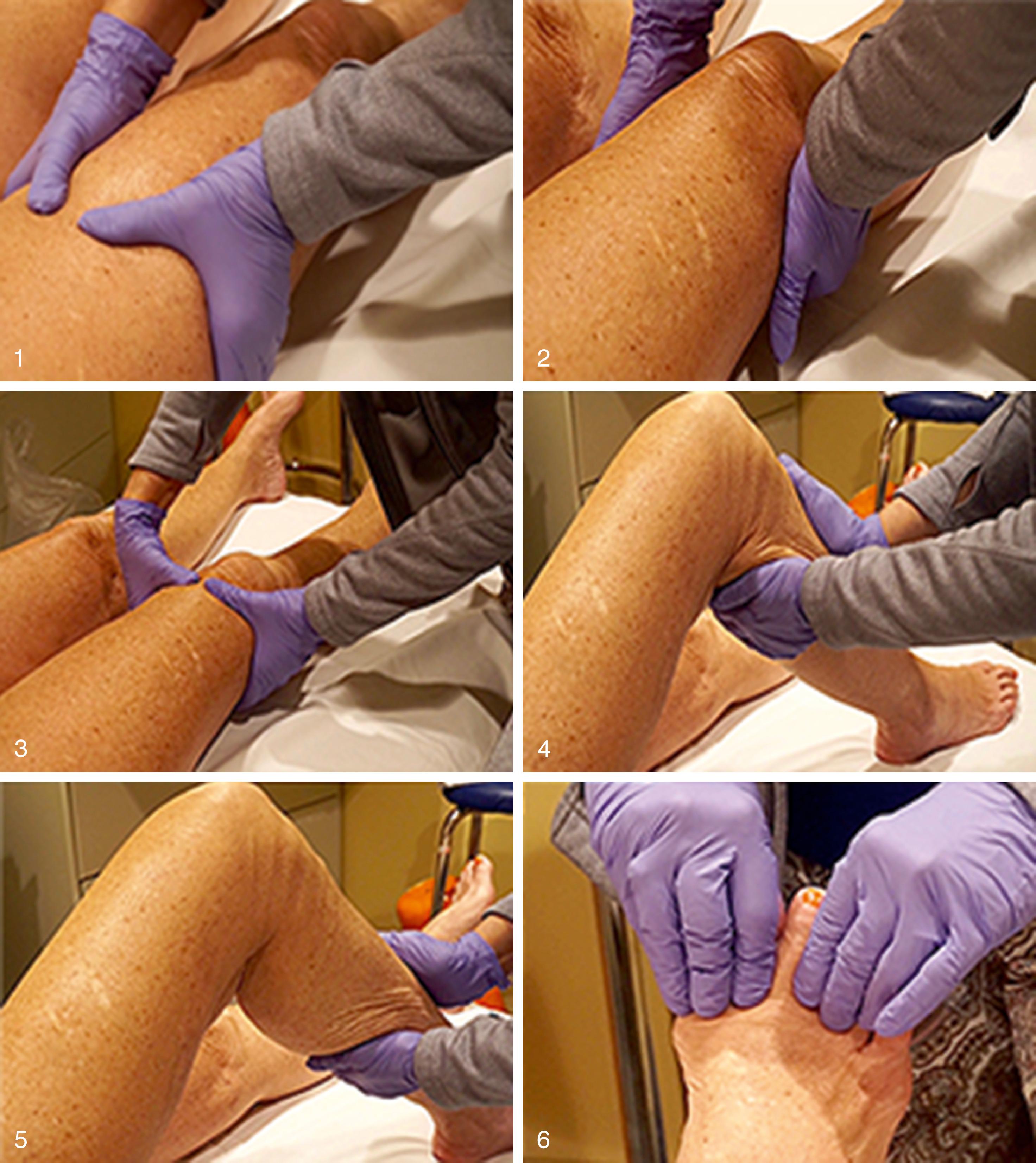
Another recent study comparing MLD to CDT showed no significant differences ( P = NS) in the five measurement levels of the arm circumference at the 5th week and 3rd month with a similar improvement in shoulder ROM, pain, tightness, and heaviness sensations in both groups ( P <0.05). Others have recommended prophylactic implementation of MLD to prevent secondary lymphedema in patients with breast cancer.
Elastic wrapping is the principal compression technique used in phase I CDT. Short-stretch bandages have been reported to be very effective in the initial management of arm lymphedema. , The wrapping requires: (1) tubular bandage lining; (2) foam, polyester, or cotton under the cast padding; (3) digit bandages; and (4) multiple layers of short bandages with limited stretchability when pulled. A recent study described the use of upper extremity compression sleeves among breast cancer survivors whose arm volumes increased by 3% from baseline. Normalization of arm volumes was achieved for the majority of patients after 4 weeks of sleeve use and was maintained for an average follow-up of 4 months. At 1 year following diagnosis, lymphedema incidence was reduced relative to previously reported rates. The goal is to create an internal pump-like action. Two different types of pressures are produced by the bandaging: (1) the low resting pressure (20 to 30 mm Hg), which is the result of short-stretch bandages on the patient during resting; and (2) the high working pressure, which is the result of short-stretch bandages on the patient during muscle contraction. The resulting cycling between high working pressures and low resting pressure under the bandages in the interstitial fluid areas mimics the action of a pump, which assists the unidirectional flow of lymph to be transported away from the congested area. Inelastic multi-component compression (ICM) bandages normally applied by specialized medical staff are considered the standard of care treatment for compression therapy related to lymphedema of the extremities. However, there are new adjustable compression wraps (ACWs), which can be self-applied by patients. To date, the ACWs have been mainly recommended during the maintenance phase; however, this could be a step toward self-management during the initial treatment phase as well. The technique of applying the elastic wrap is important to achieve an effective compression gradient; short-stretch bandages must be applied with low-to-moderate tension using more layers at the ends of the extremities. , During phase I CDT, low-stretch wraps are worn 24 hours a day (except when the patient is receiving a massage or bathing). In the maintenance phase, a compression garment is worn during the day, and the wraps continue to be worn at night. Compression bandaging is always a part of the phase I CDT. Some individuals with more severe forms of lymphedema may need to use home compression bandaging long-term as part of phase II. Although somewhat debatable, especially in the past, heating combined with compression bandaging was deemed effective treatment for chronic lymphedema with dermatolymphangioadenitis.
Compression garments are normally used during all phases of lymphedema treatment, including prophylaxis in at-risk patients. Strict adherence to the daily use of properly fitting and appropriately graduated elastic compression garments are the key components to maintaining limb size for most patients. Fitted elastic knit two-way low-stretch compression garments generate greater pressures more distally than proximally to maintain unidirectional lymphatic flow. , Normally, compression garments deliver about 20 to 50 mm Hg of pressure ( Table 168.2 ). , Generally speaking, the highest compression that can be tolerated by the patient is likely to be the most beneficial.
| Type | Garment Pressure |
|---|---|
| Over-the-counter | 7–15 mm Hg. Not graduated |
| Anti-embolism | 15–20 mm Hg. Graduated |
| Chronic venous insufficiency or lymphedema | 20–30, 30–40, 40–50, and 50–60 mm Hg |
| Patients with comorbidities | 20–30 mm Hg or less |
| Upper extremity | 20–30 mm Hg |
| Lower limbs with recalcitrant chronic lymphedema | 30–40 mm Hg |
Wearing compression bandages or garments that are too tight, restrictive, or not fitting properly may worsen limb condition. When fitted correctly and when properly worn, compression garments may reduce swelling ( Fig. 168.8 ). Support garments come in a variety of sizes, compression strengths, and materials; the different features may be selected to meet the unique needs and dimensions of individual patients ( Figs. 168.9 and 168.10 ). Although off-the-shelf prefabricated garments may fit many limbs, custom stockings may be necessary for significant swelling or an unusual shape. Compression garments should be replaced every 3 to 6 months. Contraindications for the use of compression garments include arterial insufficiency, acute cardiac failure, extreme limb shape distortion, very deep skin folds, extensive skin ulceration, severe peripheral neuropathy, and lymphorrhea. There is a lack of evidence suggesting a positive or negative effect from compression garment use during exercise. The results from current and previous research suggest the recommendation that garments must be worn during exercise is questionable, and its application requires an individualized approach.
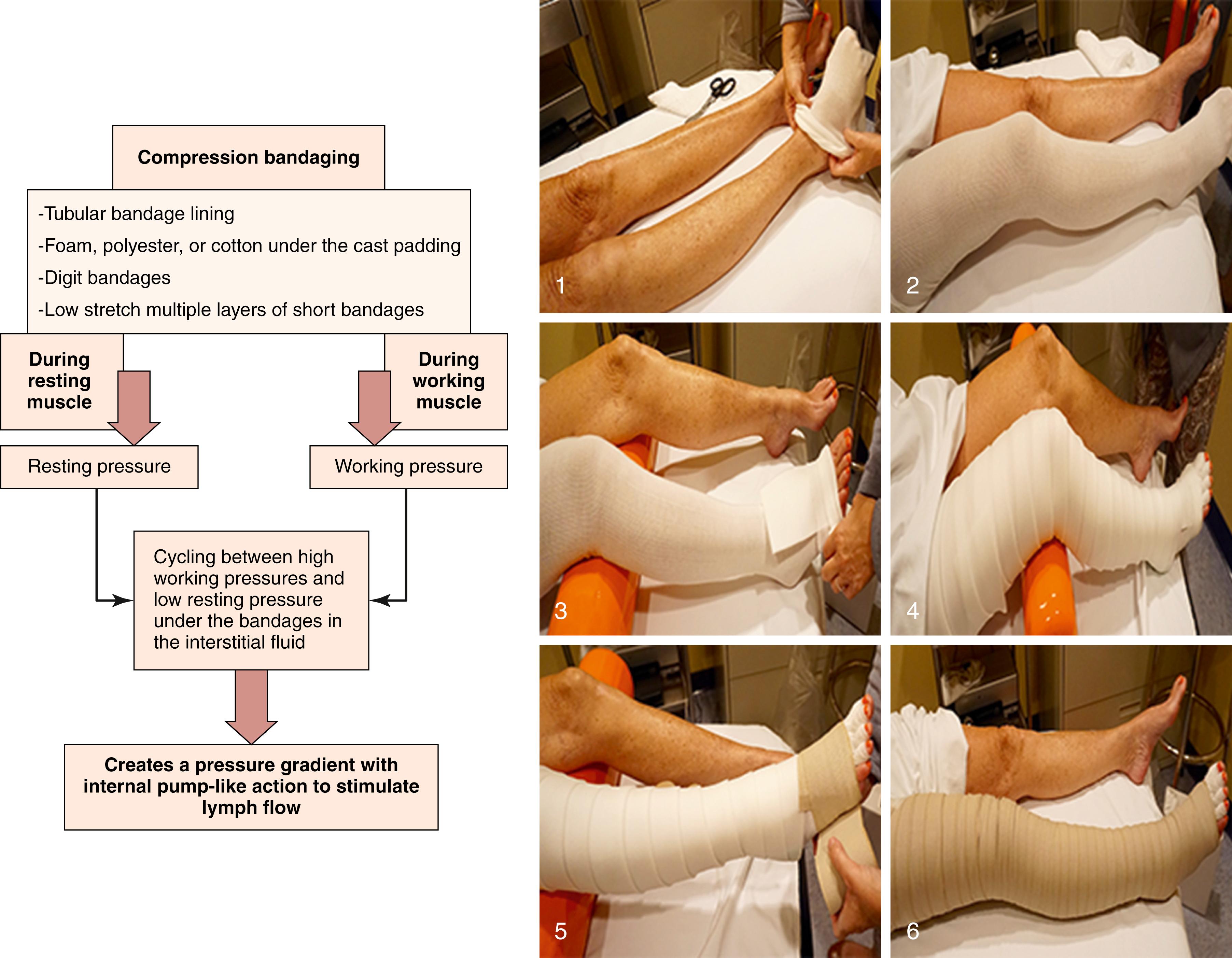
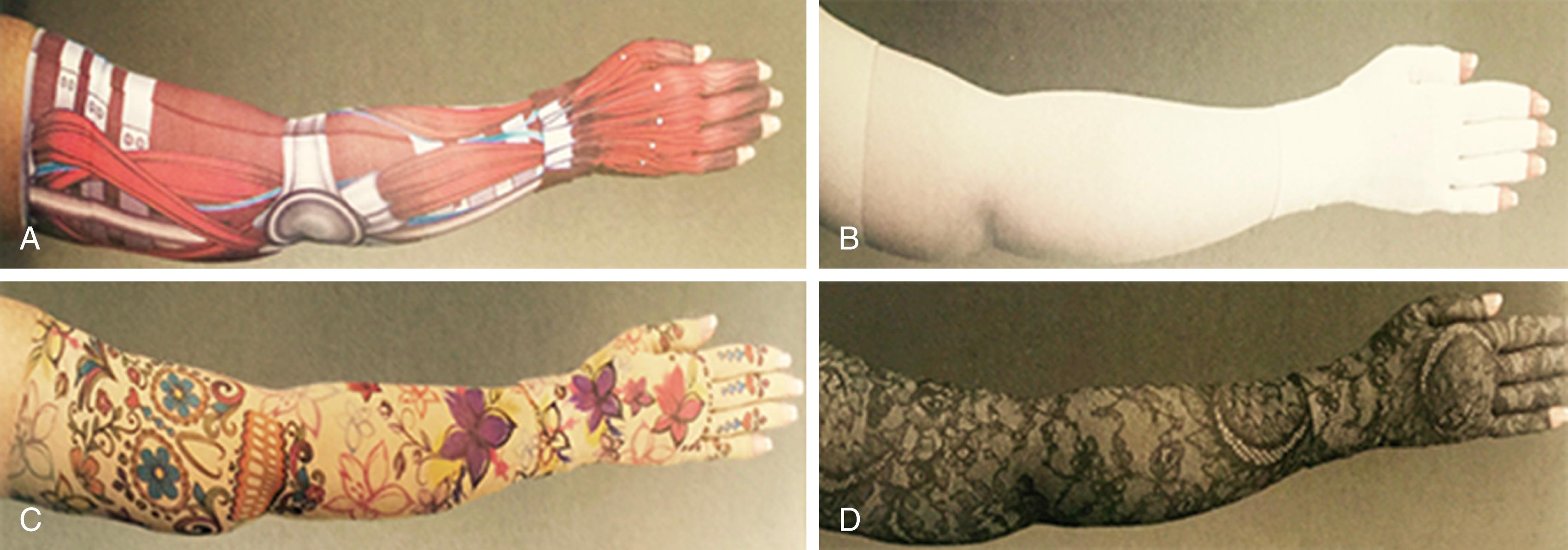

Stocking length is frequently an issue. As a general rule, stockings should be long enough to cover the edematous portion of the limb, but patient preference and physical limitations have to be considered. In general, knee-high or thigh-high compression garments with removable proximal pressure support (e.g., biking shorts, sport leotards) are better tolerated than full-length garments. Patient input in selecting among the wide range of options is key to promoting acceptance and adherence. Good garment fit is critical. Garments should never be rolled at the top, creating the possibility of an obstructing tourniquet. Creases at the ankle or in the popliteal or cubital areas can create enough pressure to cause skin breakdown. Skin should be carefully inspected for chafing or irritation after any new garment is worn.
Become a Clinical Tree membership for Full access and enjoy Unlimited articles
If you are a member. Log in here